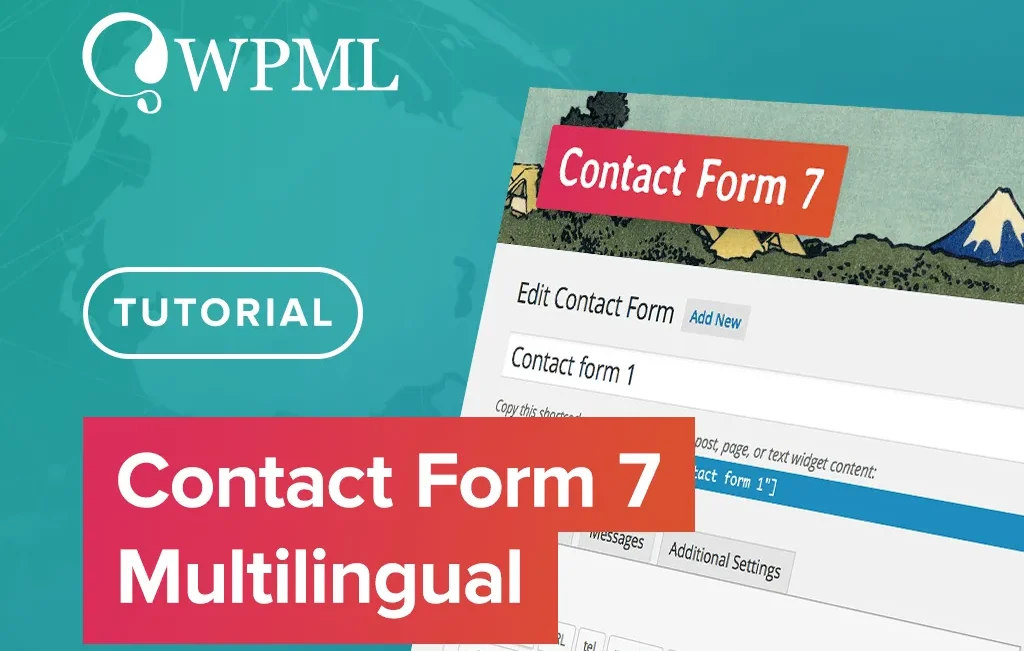Contact Form 7 Multilingual – Translate Forms with WPML
Contact Form 7 Multilingual lets you effortlessly translate the forms you create with Contact Form 7. Simply create a form and insert it into a post or page. Then, choose the best translation method for your needs.
Contact Form 7 Multilingual. One Glue Plugin, Multiple Features.
Translate the contact forms you create automatically using DeepL, Google Translate, or Microsoft Azure
Eliminates the need to create separate forms in each language
Translate form templates, form fields with multiple options, default messages, and notification email texts
Send forms for translation to professional translators or translation services integrated with WPML
No additional steps – translated embedded forms automatically display on posts and pages in the correct language
Translate forms by yourself in the Advanced Translation Editor
Contact Form 7 allows you to create, customize, and manage front-end forms for your site. In this tutorial, we provide step-by-step instructions on how to make these forms multilingual using WPML.
Here is a short video that explains the process of translating form built using the Contact Form 7 plugin:
On This Page:
Getting Started
Start by installing and activating the following plugins:
- Contact Form 7 plugin
- Contact Form 7 Multilingual plugin
- WPML core plugin and WPML String Translation add-on
If you’re new to WPML, check out our Getting Started Guide. It quickly walks you through different translation options you can use.
Translating Your Forms
To translate your forms, follow these steps:
1. Creating the Default Language Contact Form
To create your form, go to Contact → Add New. When completed, you will get a shortcode for your contact form. Copy it to later insert it into your contact page.
2. Translating the Contact Form
Now, it’s time to translate the form. WPML provides you with different ways of doing this.
Translating the Form Automatically
If you use the Translate What You Choose mode, you can automatically translate your contact forms from the Translation Management dashboard. Simply go to WPML → Translation Management, find and select your form, and click to automatically translate it.
Translating automatically from the Translation Management Dashboard
Send the Form to be Translated by Others
Go to WPML → Translation Management to send all types of content, including contact forms, for translation.
You can send any content, including forms, to be translated by your own translators, or by one of many professional translation services integrated with WPML.
You can find detailed instructions on how to do this in our guide about using WPML’s Translation Management.
Translate the Form Yourself
Alternatively, you can translate the form yourself. To do this, edit the form and in the Language box, click the plus icon corresponding to the language you want to translate your form into.
Clicking the plus icon to translate the form
This takes you to WPML’s Advanced Translation Editor (ATE), where you can translate the form and placeholder texts. If you have translation credits, you’ll see the translations automatically filled in. If you don’t have credits, you need to add the translations by yourself.
Translating Contact Form 7 texts in the Advanced Translation Editor
Translating the Submit Button and Select, Radio, and Checkbox Fields
All the forms you create include a Submit button. Contact Form 7 also gives you the option to add checkboxes, radio buttons, and drop-down menus to your forms. This allows you to create fields with multiple choices, like a checkbox for users to pick their country of residence.
To translate the Submit button and the values of fields from checkboxes, radio buttons, and other select field types, you need to search for the text in the Advanced Translation Editor.
When you search for the field value in the Advanced Translation Editor, you may see the text appear twice, labeled as shortcode and shortcode-attr. Only translate the field labeled as shortcode attribute (shortcode-attr). This shortcode attribute (shortcode-attr) holds the value that needs translation, while shortcode (shortcode) represents the code and should never be translated.
Start by opening the form for translation in the Advanced Translation Editor. Then:
- Search for the value of the field that you want to translate. In our example, we are searching for the Submit button.
- Click the plus icon next to your text labeled as a shortcode attribute (shortcode-attr) and enter the translation.
- Save the translation by clicking on the check mark in the green box.
Translating the Submit button in a contact form
Repeat these steps for all values coming from the buttons or multiple choice fields in the form.
3. Inserting the Block Into the Content
Now you need to insert your form into a post, page, or widget in the default language. To do this, simply insert the Contact Form 7 block and select your form using a dropdown.
Selecting the form in the drop-down
4. Translating Content With Embedded Forms
Finally, you need to translate the pages, posts, or widgets that hold the forms. Just like translating the forms, you can send these to be translated by others, or you can do it manually yourself.
To translate it yourself, edit the post or a page and use the Language box to translate or duplicate it.
Using the Language box to translate or duplicate content
Make sure to translate only the texts. Do not change anything within the shortcode. WPML automatically displays the form in the correct language.
Non-translatable Form Elements
There are certain form elements whose texts come from your browser and not Content Form 7 or WPML. This includes elements like the Browse and Upload File buttons and reCAPTCHA.
A user visiting your site will see these fields displayed based on the default language of their browser.
Translated page with a non-translatable browser element









Reviews
Clear filtersThere are no reviews yet.